Seramik Sanatında İfade Biçimi Olarak Erotizm: Sergei Isupov’un Sürrealist Heykel Örnekleri
Sanatçı, yaşamı ve zamanı sıra dışı bir şekilde algılayan, yüksek benliğinin süzgecinden geçirdiği kavramları var etme sürecinde kullanan kişidir. Bu kavramlardan bir tanesi de erotizmdir. Sanatta erotizm, toplumun ve coğrafyanın sahip olduğu güç dengeleri nedeniyle sanatçıların kaçındıkları ya da sınırları zorladıkları bir kavram olarak belirmektedir. Bu durumun yanı sıra erotizm, bilinçaltını ve hayal dünyasını eserlerinde temellendiren sürrealistler için dominant niteliktedir. Araştırma kapsamında nitel araştırma yöntemlerinden alanyazın araştırması, örneklem analizleri kullanılmıştır. Toplumların erotizme bakışı, genel sanat anlayışlarına etkileri literatür taramasının kısa bir özetiyle sunulmuştur. Araştırma dâhilinde kendisini Erotik Sürrealist Seramik Sanatçısı olarak tanımlayan Sergei Isupov’un eserleri teknik, biçim ve kavramsal açıdan incelenerek erotizm kavramının bir ifade aracı olarak kullanım biçimleri tartışılmaya çalışılmıştır. Isupov, erotizm kavramını bilgi aktarma ya da mesaj verme çabası olmadan bilinçaltını ve fantezi dünyasını yaratıcı biçimde birleştirerek özgün bir anlatım dili geliştirmiştir. Tarihöncesi toplumlardan itibaren yaşamın ve varoluşun güçlü, doğal ve vazgeçilmez bir olgusu olarak görülen erotizm kavramı, seramik kullanım eşyaları ya da sanat objeleri üzerinden çağlar boyunca irdelenmiştir. Sonuç kısmında Isupov örneği ile birlikte erotizm kavramının seramik heykel anlatımlarında üç boyut ile sınırlı kalmayarak iki boyutlu illüstratif etkiler olarak yansıtıldığı da aktarılmıştır. Erotizm kavramının sahip olduğu tarihsel bağlarının ve sanatsal ifade olanaklarının çağdaş seramik sanatçılarına biçimsel ve kavramsal açılardan yeni yollar oluşturacağı öngörülmektedir.
Anahtar Kelimeler:
Erotizm, Sürrealizm, Seramik Heykel, Sergei Isupov
Erotism as an Expression in Ceramic Art: Examples of Sergei Isupov's Surrealist Sculpture
Artist is a person who perceives life and time in an extraordinary way and uses the concepts filtered by higher self in the process of creating. One of these concepts is eroticism. Eroticism in art appears as a concept that artists avoid or push the limits due to the power balances of society and geography. In addition to this situation, eroticism is dominant for surrealists who base their artworks on the subconscious and imagination. Within the scope of the research, literature research and sample analyzes from qualitative research methods were used. The society’s view of eroticism and its effects on general understanding of art are presented with a brief summary of the literature review. Within the scope of the research, the artworks of Sergei Isupov, who defines himself as an Erotic Surrealist Ceramic Artist, were examined in terms of technique, form and conceptual, and the possibilities of using the concept of eroticism as a means of expression were tried to be discussed. Isupov has developed a unique language of expression by creatively combining the subconscious and fantasy world without an effort to convey information or give a message. The concept of eroticism, which has been seen as a strong, natural and indispensable phenomenon of life and existence since prehistoric societies, has been examined through the ages through ceramic products or art objects. In the conclusion part, it is also stated that the concept of eroticism is not limited to three dimensions in the expressions of ceramic sculptures, but is reflected as two-dimensional illustrative effects, together with the example of Isupov. It is predicted that the historical ties and artistic expression possibilities of the concept of eroticism will create new ways for contemporary ceramic artists in terms of form and concept.
Keywords:
Eroticism, Surrealism, Ceramic Sculpture, Sergei Isupov,
___
- Aktunç, H. (2002). Erotologya? Bir Türkiye Erotologya’sına giriş için denemeler. YKY Yayınları.
- Baynes, K. (2012). Toplumda sanat (4. Baskı). (Y. Atılgan, Çev.). Yapı Kredi Yayınları. ISBN: 978-975-08-0430-9.
- Breton, A. (2009). Sürrealist manifestolar (1. Baskı). Altıkırkbeş Yayın.
- Etimoloji Türkçe. Erotik kelime kökeni. www.etimolojiturkce.com/arama/erotik (05.11.2021).
- Foucault M. (2007). Cinselliğin tarihi (2. Baskı). (H. Uğur Tanrıöver, Çev.). Ayrıntı Yayınları.
- Isupov, S. About. Sergei Isupov. https://sergeiisupov.com/about (20.11.2021).
- İnatçı, Ü. (2011). Sanatta erotizm ve yaşamseverlik. rh+ Art Magazine Dergisi, 82, 41-45.
- İnatçı, Ü. (2012). Sanat ve direniş. Söylem Matbaacılık. ISBN: 978-9963-2867-0-6.
- Klingsöhr-Leory, C. (2006). Gerçeküstücülük (Sürrealizm). Taschen / Remzi kitabevi.
- Korukçu, M. M. (2009). Bir anlatım biçimi olarak erotik ve tiyatro estetiğinde kullanımı. [Dokuz Eylül Üniversitesi Güzel Sanatlar Enstitüsü Sahne Sanatları Anasanat Dalı Doktora Tezi, İzmir].
- Markus, R. (2000). Surrealism’s praying mantis and casrating women. Woman’s Art Journal, 21(1), 33-39.
- Mathieu, P. (2003). Sex pots eroticism in ceramics. Rutgers University Press.
- Moran, B. (2012). Edebiyat kuramları ve eleştiri. İletişim Yayınları.
- Tatar, O. (2020). Çıplak bedenin kamusal alanda eleştiri nesnesi olarak kullanımı: Spencer Tunick’in enstalasyonları. Yedi: Sanat, Tasarım ve Bilim Dergisi, 24, 57-70. https://doi.org/10.17484/yedi.727108
- Türk Dil Kurumu (TDK). www.tdk.gov.tr (10.11.2021).
- Türk, S. A. & Midilli Sarı, R. (2020). Eğitim yapısı tasarımını duyular üzerinden (yeniden) düşünmek. Sanat ve Tasarım Dergisi, 26, 719-750. https://dergipark.org.tr/en/pub/sanatvetasarim/issue/58750/848526
- Wiley, H. (2019). Sex pots: 50 shades of moche. Culture, Society, and Praxis, 11(1), 1-4.
- Yayın Aralığı: Yılda 2 Sayı
- Başlangıç: 2022
- Yayıncı: Mugla Sitki Kocman University
Sayıdaki Diğer Makaleler
Mimaride Sürdürülebilir Malzeme “Bambu”
Özlem AYDIN, Didem BAYRAKTAR MARANGOZ
Seramik Sanatında İfade Biçimi Olarak Erotizm: Sergei Isupov’un Sürrealist Heykel Örnekleri
İç Mekân Tasarımında Tasarım Odaklı Düşünme Modeli; Kırmızılı Kadın Belgeseli
Menşure Kübra MÜEZZİNOĞLU, Mehmet NORASLI
İç Mimarlık Eğitiminde Strüktür ve Proje Derslerinin Entegrasyonu; Tiny House Örneği
Herbert Read’in Modern Sanat Felsefesi ve Evrensellik Düşüncesi
21. Yüzyıl Sanatında Yok-Yerler İmgesi
Mekân Kavramının Yörük Kilimleri Üzerinden Değerlendirilmesi
Purity of Essence in Architecture, A Radical Revolution in Human-Building Interaction
